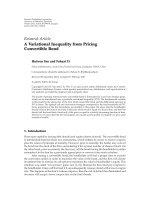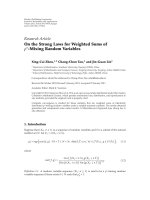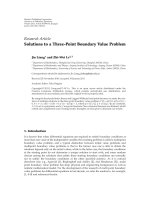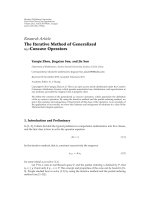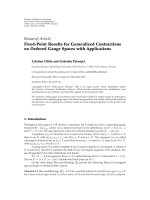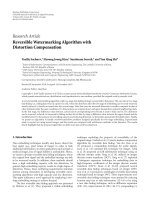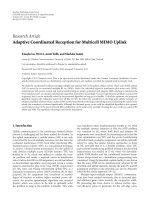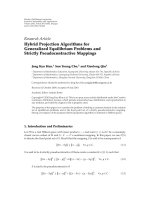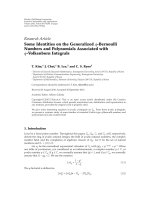báo cáo hóa học:" Research Article Fractional-Order Variational Calculus with Generalized Boundary Conditions" doc
Bạn đang xem bản rút gọn của tài liệu. Xem và tải ngay bản đầy đủ của tài liệu tại đây (485.45 KB, 9 trang )
Hindawi Publishing Corporation
Advances in Difference Equations
Volume 2011, Article ID 357580, 9 pages
doi:10.1155/2011/357580
Research Article
Fractional-Order Variational Calculus with
Generalized Boundary Conditions
Mohamed A. E. Herzallah
1, 2
and Dumitru Baleanu
3, 4
1
Faculty of Science, Zagazig University, Zagazig, Egypt
2
Faculty of Science in Zulfi, Majmaah University, Zulfi 11932, P.O. Box 1712, Saudi Arabia
3
Department of Mathematics and Computer Science, C¸ ankaya University,
06530 Ankara, Turkey
4
Institute for Space Sciences, P.O.Box MG-23 Magurele, 76900 Bucharest, Romania
Correspondence should be addressed to Dumitru Baleanu,
Received 18 September 2010; Accepted 8 November 2010
Academic Editor: J. J. Trujillo
Copyright q 2011 M. A. E. Herzallah and D. Baleanu. This is an open access article distributed
under the Creative Commons Attribution License, which permits unrestricted use, distribution,
and reproduction in any medium, provided the original work is properly cited.
This paper presents the necessary and sufficient optimality conditions for fractional variational
problems involving the right and the left fractional integrals and fractional derivatives defined in
the sense of Riemman-Liouville with a Lagrangian depending on the free end-points. To illustrate
our approach, two examples are discussed in detail.
1. Introduction
Fractional calculus is one of the generalizations of the classical calculus. Several fields of
application of fractional differentiation and fractional integration are already well estab-
lished, some others have just started. Many applications of fractional calculus can be found in
turbulence and fluid dynamics, stochastic dynamical system, plasma physics and controlled
thermonuclear fusion, nonlinear control theory, image processing, nonlinear biological
systems, astrophysics, and so forth see 1–11 and the references therein.
Real integer variational calculus plays a significant role in many areas of science,
engineering, and applied mathematics. In recent years, there has been a growing interest
in the area of fractional variational calculus and its applications which include classical and
quantum mechanics, field t heory, and optimal control see 10, 12 –20 .
In the papers cited above, the problems have been formulated mostly in terms of two
types of fractional derivative, namely, Riemann-Liouville RL and Caputo derivatives.
2 Advances in Difference Equations
The natural boundary conditions for fractional variational problems, in terms of the
RL and the Caputo derivatives, are presented in 13, 14 .
The necessary optimality conditions for problems of the f ractional calculus of vari-
ations with a Lagrangian that may also depend on the unspecified end-points y(a), y(b) is
proven in 19.
In 18 the two authors discussed the fractional variational problems with fractional
integral and fractional derivative in the sense of Riemann-Liouville and the Caputo
derivatives and give the fractional Euler-Lagrange equations with the natural boundary
conditions.
Here we develop the theory of fractional variational calculus further by proving
the necessary optimality conditions for more general problems of the fractional calculus
of variations with a fractional integral and a Lagrangian that may also depend on the
unspecified end-points y(a) or y(b). The novelty is the dependence of the integrand L on the
free end-points y(a), y(b) with replacing the ordinary integral by fractional integral in the
functional.
We consider two types of fractional variational calculus
J
y
I
γ
a
L
x, y
x
,
R
D
α
a
y, y
a
, 1.1
J
y
I
γ
b−
L
x, y
x
,
R
D
α
b−
y, y
b
. 1.2
The paper is organized as follows.
In Section 2, we present the principal definitions used in this paper. In Section 3,
the necessary optimality conditions are proved for problems 1.1 and 1.2 by giving some
special cases which prove the generalization of our problems. Sufficient conditions are shown
in Section 4, and two examples are depicted in Section 5.
2. Preliminaries
Here we give the standard definitions of left and right Riemann-Liouville fractional integral,
Riemann-Liouville fractional derivatives, and Caputo fractional derivatives see 1, 2, 4, 21.
Definition 2.1. If ft ∈ L
1
a, b, the set of all integrable functions, and α>0, then the left and
right Riemann-Liouville fractional integrals of order α, denoted, respectively, by I
α
a
and I
α
b−
,
are defined by
I
α
a
f
t
1
Γ
α
t
a
t − τ
α−1
f
τ
dτ,
I
α
b−
f
t
1
Γ
α
b
t
τ − t
α−1
f
τ
dτ.
2.1
Advances in Difference Equations 3
Definition 2.2. For α>0, the left and right Riemann-Liouville fractional derivatives of order
α, denoted, respectively, by
R
D
α
a
and
R
D
α
b−
, are defined by
R
D
α
a
f
t
1
Γ
n − α
D
n
t
a
t − τ
n−α−1
f
τ
dτ,
R
D
α
b−
f
t
1
Γ
n − α
−D
n
b
t
τ − t
n−α−1
f
τ
dτ,
2.2
where n is such that n − 1 <α<nand D d/dt
If α is an integer, these derivatives are defined in the usual sense
R
D
α
a
: D
α
,
R
D
α
b−
:
−D
α
,α 1, 2, 3, 2.3
Definition 2.3. For α>0, the left and right Caputo fractional derivatives of order α, denoted,
respectively, by
C
D
α
a
and
C
D
α
b−
, are defined by
C
D
α
a
f
t
1
Γ
n − α
t
a
t − τ
n−α−1
D
n
f
τ
dτ,
C
D
α
b−
f
t
1
Γ
n − α
b
t
τ − t
n−α−1
−D
n
f
τ
dτ,
2.4
where n is such that n − 1 <α<nand D d/dτ.
If α is an integer, then these derivatives take the ordinary derivatives
C
D
α
a
D
α
,
C
D
α
b−
−D
α
,α 1, 2, 3, 2.5
3. Necessary Optimality Conditions
3.1. Necessary Optimality Conditions for Problem 1.1
To develop the necessary conditions for the extremum for 1.1, assume that y
∗
x is the
desired function, let ∈ R, and define a family of curves yxy
∗
xηx since
R
D
α
a
is a
linear operator; then we get 1.1 in the form
J
x
a
x − t
γ−1
Γ
γ
L
t, y
t
η
t
,
R
D
α
a
y
R
D
α
a
η, y
a
η
a
dt
3.1
and where J() is extremum at 0, we get by differentiating both sides with respect to and
set dJ/d 0, for all admissible η(x),
x
a
x − t
γ−1
Γ
γ
∂L
∂y
η
∂L
∂
R
D
α
a
y
R
D
α
a
η
∂L
∂y
a
η
a
dt 0. 3.2
4 Advances in Difference Equations
But we have by integration by parts in classic and fractional calculus
x
a
x − t
γ−1
Γ
γ
∂L
∂
R
D
α
a
y
R
D
α
a
η
dt
x − t
γ−1
Γ
γ
∂L
∂
R
D
α
a
y
I
1−α
a
η
t
x
a
−
x
a
I
1−α
a
η
t
D
x − t
γ−1
Γ
γ
∂L
∂
C
D
α
a
y
dt
x − t
γ−1
Γ
γ
∂L
∂
R
D
α
a
y
I
1−α
a
η
t
x
a
x
a
η
t
R
D
α
x−
x − t
γ−1
Γ
γ
∂L
∂
C
D
α
a
y
dt.
3.3
Substituting in 3.2,weget
x
a
η
t
x − t
γ−1
Γ
γ
∂L
∂y
C
D
α
x−
x − t
γ−1
Γ
γ
∂L
∂
R
D
α
a
y
dt
x − t
γ−1
Γ
γ
∂L
∂
R
D
α
a
y
I
1−α
a
η
t
tx
−
x − t
γ−1
Γ
γ
∂L
∂
R
D
α
a
y
I
1−α
a
η
t
ta
η
a
x
a
x − t
γ−1
Γ
γ
∂L
∂y
a
dt
0.
3.4
Since η(t) is arbitrary, we get I
1−α
a
ηt|
ta
0andI
1−α
a
ηt|
tx
/
0 which gives the fractional
Euler-Lagrange equation in the form
x − t
γ−1
Γ
γ
∂L
∂y
C
D
α
x−
x − t
γ−1
Γ
γ
∂L
∂
R
D
α
a
y
0
3.5
with the natural boundary condition transversality conditions
x − t
γ−1
Γ
γ
∂L
∂
R
D
α
a
y
tx
0
. 3.6
If y(a) is specified, then we have ηa0, but if it is not specified, then we get the boundary
condition
x
a
x − t
γ−1
Γ
γ
∂L
∂y
a
dt 0.
3.7
Remark 3.1. These conditions are only necessary for an extremum. The question of sufficient
conditions for the existence of an extremum is considered in the next section.
Advances in Difference Equations 5
Special Cases
Case 1. If y is a local extremizer to
J
y
b
a
L
t, y
t
,
R
D
α
a
y
dt,
3.8
by putting γ 1andx b in 3.5, 3.6,and3.7, we get the fractional Euler-Lagrange
equation in the form
∂L
∂y
C
D
α
b−
∂L
∂
R
D
α
a
y
0
3.9
for all t ∈ a, b, with the boundary condition
∂L
∂
R
D
α
a
y
tx
0.
3.10
Case 2. If y is a local extremizer to
J
y
I
γ
L
x, y
x
,
R
D
α
a
y
, 3.11
we get similar results as in 18.
3.2. Necessary Optimality Conditions for Problem 1.2
To develop the necessary conditions for the extremum for 1.2, assume that y
∗
x is the
desired function, let ∈ R, and define a family of curves yxy
∗
xηx since
R
D
β
b−
is a
linear operator; then we get 1.2 in the form
J
b
x
t − x
γ−1
Γ
γ
L
t, y
t
η
t
,
R
D
α
b−
y
R
D
α
b−
η, y
b
η
b
dt
3.12
and where J is extremum at 0, we get by differentiating both sides with respect to
and set dJ/d 0, for all admissible ηx,
b
x
t − x
γ−1
Γ
γ
⎡
⎣
∂L
∂y
η
∂L
∂
R
D
β
b−
y
R
D
β
b−
η
∂L
∂y
b
η
b
⎤
⎦
dt 0. 3.13
6 Advances in Difference Equations
But we have by integration by parts that
b
x
⎛
⎝
t − x
γ−1
Γ
γ
∂L
∂
R
D
β
b−
y
R
D
β
b−
η
⎞
⎠
dt
−
⎛
⎝
⎛
⎝
t − x
γ−1
Γ
γ
∂L
∂
R
D
β
b−
y
⎞
⎠
I
1−β
b−
η
⎞
⎠
b
x
b
x
η
C
D
β
x
⎛
⎝
t − x
γ−1
Γ
γ
∂L
∂
R
D
β
b−
y
⎞
⎠
dt.
3.14
Substituting in 3.13,weget
b
x
η
t
⎡
⎣
t − x
γ−1
Γ
γ
∂L
∂y
C
D
β
x
⎛
⎝
t − x
γ−1
Γ
γ
∂L
∂
R
D
β
b−
y
⎞
⎠
⎤
⎦
dt
−
⎛
⎝
⎛
⎝
t − x
γ−1
Γ
γ
∂L
∂
R
D
β
b−
y
⎞
⎠
I
1−β
b−
η
⎞
⎠
b
x
η
b
b
x
t − x
γ−1
Γ
γ
∂L
∂y
b
dt 0.
3.15
Since η(t) is arbitrary, we get I
1−α
b−
ηt|
tb
0andI
1−α
b−
ηt|
tx
/
0 which gives the fractional
Euler-Lagrange equation in the form
t − x
γ−1
Γ
γ
∂L
∂y
C
D
β
x
⎛
⎝
t − x
γ−1
Γ
γ
∂L
∂
R
D
β
b−
y
⎞
⎠
0 3.16
with the natural boundary condition transversality conditions
⎛
⎝
⎛
⎝
t − x
γ−1
Γ
γ
∂L
∂
R
D
β
b−
y
⎞
⎠
⎞
⎠
tx
0
. 3.17
If y(b) is specified, then we have ηb0, but i f it is not specified, then we get the boundary
condition
b
x
t − x
γ−1
Γ
γ
∂L
∂y
b
dt 0.
3.18
4. Sufficient Conditions
In this section, we prove the sufficient conditions that ensure the existence of a minimum
maximum. Some conditions of convexity concavity are in order.
Advances in Difference Equations 7
Given a function L Lt, y, z, u, we say that L is jointly convex concave in y, z, u
if ∂L/∂y, ∂L/∂z, ∂L/∂u exist and are continuous and verify the following condition:
L
t, y y
1
,z z
1
,u u
1
− L
t, y, z, u
≥
≤
∂L
∂y
y
1
∂L
∂z
z
1
∂L
∂u
u
1
4.1
for all t, y, z, u, t, y y
1
,z z
1
,u u
1
∈ a, b × R
3
.
Theorem 4.1. Let L (t, y, z, u ) be jointly convex (concave) in (y, z, u ). If y
0
satisfies conditions 3.5
3.7,theny
0
is a global minimizer (maximizer) to problem 1.1.
Proof. We will give the proof for only the convex case and similarly we can prove it for the
concave case. Since L is jointly convex in y, z, u, v for any admissible function y
0
h,we
have
J
y
0
h
− J
y
0
x
a
x − t
γ−1
Γ
γ
L
t, y
0
t
h
t
,
R
D
α
a
y
0
t
h
t
y
0
a
h
a
−L
t, y
0
t
,
R
D
α
a
y
0
t
,
R
D
β
b−
y
0
t
,y
0
a
dt
≥
x
a
x − t
γ−1
Γ
γ
∂L
∂y
0
h
∂L
∂
R
D
α
a
y
0
R
D
α
a
h
∂L
∂y
0
a
h
a
dt.
4.2
By using integration by parts as in proving 3.5–3.7,weget
J
y
0
h
− J
y
0
≥
x
a
h
t
⎡
⎣
x − t
γ−1
Γ
γ
∂L
∂y
C
D
β
x−
⎛
⎝
x − t
γ−1
Γ
γ
∂L
∂
R
D
β
a
y
⎞
⎠
⎤
⎦
dt
−
⎛
⎝
⎛
⎝
x − t
γ−1
Γ
γ
∂L
∂
R
D
β
a
y
⎞
⎠
I
1−β
a
h
t
⎞
⎠
x
a
h
a
b
x
x − t
γ−1
Γ
γ
∂L
∂y
b
dt.
4.3
Since y
0
satisfies conditions 3.5–3.7,thusweobtainJy
0
h − Jy
0
≥ 0 which completes
the proof.
Similar to proving the previous theorem, we can prove the following theorem.
Theorem 4.2. Let L (t, y, z, u ) be jointly convex (concave) in (y,z,u ). If y
0
satisfies conditions
3.16–3.18,theny
0
is a global minimizer (maximizer) to problem 1.2.
5. Examples
We will provide in this section two examples in order to illustrate our main results.
8 Advances in Difference Equations
Example 5.1. Consider the following problem:
min J
y
1
2
I
γ
0
y
2
t
R
D
α
0
y
t
2
δ
y
0
2
,x∈
0, 1
,δ≥ 0. 5.1
For this problem, we get the generalized fractional Euler-Lagrange equational and the natural
boundary conditions, respectively, in the following form:
x − t
γ−1
Γ
γ
y
t
C
D
α
x−
x − t
γ−1
Γ
γ
R
D
α
0
y
t
0,
x − t
γ−1
Γ
γ
R
D
α
0
y
tx
0,
x
0
x − t
γ−1
Γ
γ
δy
0
dt 0.
5.2
Note that it is difficult to solve the above fractional equations; for 0 <α<1, a numerical
method should be used, and where Ly, z,u1/2y
2
z
2
δu
2
is a jointly convex then the
obtained solution is a global minimizer to problem 5.1.
Example 5.2. Consider the following problem:
min J
y
1
2
I
γ
1−
y
2
t
R
D
β
1−
y
t
2
λ
y
1
2
,x∈
0, 1
,λ≥ 0. 5.3
For this problem, we get the generalized fractional Euler-Lagrange equational and the natural
boundary conditions, respectively, in the following form:
t − x
γ−1
Γ
γ
y
C
D
β
x
t − x
γ−1
Γ
γ
R
D
β
1−
y
0,
t − x
γ−1
Γ
γ
R
D
β
1−
y
tx
0,
1
x
t − x
γ−1
Γ
γ
λy
1
dt 0.
5.4
Using a numerical method, we get the solution which is a global minimizer to problem 5.3
where Ly, z,u1/2y
2
z
2
λu
2
is a jointly convex.
Acknowledgment
The first author would like to thank Majmaah University in Saudi Arabia for financial support
and for providing the necessary facilities.
Advances in Difference Equations 9
References
1 K. S. Miller and B. Ross, An Introduction to the Fractional Calculus and Fractional Differential Equations,
A Wiley-Interscience Publication, John Wiley & Sons, New York, NY, USA, 1993.
2 I. Podlubny, Fractional Differential Equations, vol. 198, Academic Press, San Diego, Calif, USA, 1999.
3 R. Hilfe, Applications of Fractional Calculus in Physics, World Scientific Publishing, River Edge, NJ, USA,
2000.
4 A. A. Kilbas, H. M. Srivastava, and J. J. Trujillo, Theory and Applications of Fractional Differential
Equations, vol. 204 of North-Holland Mathematical Studies, Elsevier, Amsterdam, the Netherlands, 2006.
5 R. L. Magin, “Fractional calculus in bioengineering, part 1,” Critical Reviews in Biomedical Engineering,
vol. 32, no. 1, pp. 1–104, 2004.
6 R. L. Magin, “Fractional calculus in bioengineering, part 2,” Critical Reviews in Biomedical Engineering,
vol. 32, no. 2, pp. 105–193, 2004.
7 R. L. Magin, “Fractional calculus in bioengineering, part3,” Critical Reviews in Biomedical Engineering,
vol. 32, no. 3-4, pp. 195–377, 2004.
8 L. Debnath, “Recent applications of fractional calculus to science and engineering,” International
Journal of Mathematics and Mathematical Sciences, no. 54, pp. 3413–3442, 2003.
9 N. M. Fonseca Ferreira, F. B. Duarte, M. F. M. Lima, M. G. Marcos, and J. A. Tenreiro
Machado, “Application of fractional calculus in the dynamical analysis and control of mechanical
manipulators,” Fractional Calculus & Applied Analysis, vol. 11, no. 1, pp. 91–113, 2008.
10 G. S. F. Frederico and D. F. M. Torres, “Fractional conservation laws in optimal control theory,”
Nonlinear Dynamics, vol. 53, no. 3, pp. 215–222, 2008.
11 V. V. Kulish and J. L. Lage, “Application of fractional calculus to fluid mechanics,” Journal of Fluids
Engineering, vol. 124, no. 3, pp. 803–806, 2002.
12 O. P. Agrawal, “Formulation of Euler-Lagrange equations for fractional variational problems,” Journal
of Mathematical Analysis and Applications, vol. 272, no. 1, pp. 368–379, 2002.
13 O. P. Agrawal, “Fractional variational calculus and the transversality conditions,” Journal of Physics A,
vol. 39, no. 33, pp. 10375–10384, 2006.
14
O. P. Agrawal, “Generalized Euler- Lagrange equations and transversality conditions for FVPs in
terms of the Caputo derivative,” Journal of Vibration and Control, vol. 13, no. 9-10, pp. 1217–1237, 2007.
15 R. Almeida, A. B. Malinowska, and D. F. M. Torres, “A fractional calculus of variations for multiple
integrals with application to vibrating string,” Journal of Mathematical Physics, vol. 51, no. 3, 2010.
16 D. Baleanu and O. P. Agrawal, “Fractional Hamilton formalism within Caputo’s derivative,”
Czechoslovak Journal of Physics, vol. 56, no. 10-11, pp. 1087–1092, 2006.
17 D. Baleanu, S. I. Muslih, and E. M. Rabei, “On fractional Euler-Lagrange and Hamilton equations and
the fractional generalization of total time derivative,” Nonlinear Dynamics, vol. 53, no. 1-2, pp. 67–74,
2008.
18 M. A. E. Herzallah and D. Baleanu, “Fractional-order Euler-Lagrange equations and formulation of
Hamiltonian equations,” Nonlinear Dynamics, vol. 58, no. 1-2, pp. 385–391, 2009.
19 A. B. Malinowska and D. F. M. Torres, “Generalized natural boundary conditions for fractional
variational problems in terms of the Caputo derivative,” Computers & Mathematics with Applications,
vol. 59, no. 9, pp. 3110–3116, 2010.
20 S. I. Muslih and D. Baleanu, “Fractional Euler-Lagrange equations of motion in fractional space,”
Journal of Vibration and Control, vol. 13, no. 9-10, pp. 1209–1216, 2007.
21 S. G. Samko, A. A. Kilbas, and O. I. Marichev, Fractional Integrals and Derivatives: Theory and
Applcations, Gordon and Breach, New York, NY ,USA, 1987, Translated from the Russian.
